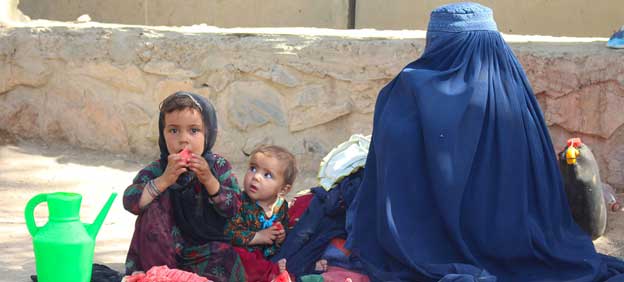Crisis in Afghanistan: All Eyes on Central Asia

WASHINGTON DC, Aug 27 (IPS) - The political and human catastrophe in Afghanistan is threatening to boost autocratic tendencies in Tajikistan and Uzbekistan.
With the withdrawal of US and coalition forces from Afghanistan and the rapid takeover by the Taliban, neighbouring Central Asian countries are once again at the focus of international attention.
Countries that share a border with Afghanistan — Tajikistan, Uzbekistan, and Turkmenistan — are now vital in providing support for security operations for the Afghan people while also dealing with security concerns of their own.
A Taliban-controlled Afghanistan is not new for these Central Asian countries. The Taliban expanded rapidly across Afghanistan shortly after the region gained independence from the Soviet Union in 1991.
But unlike the 1990s, when the Central Asian countries were just beginning to learn to function as independent states and their future seemed uncertain, today’s developments in Afghanistan unfold against the background of established autocracies known for their willingness to suppress domestic dissents and benefit from security crises to consolidate their hold on power.
Tajikistan is a particularly stark example of domestic changes that took place since the 1990s. Then, the country was divided by a civil war between the secular post-communist government and the religious-political opposition. In the summer of 1997, a Peace Accord was brokered through the mediation of Russia and Uzbekistan, shortly after the Taliban took over Kabul.
The Tajik president Emomali Rakhmon (then known as Rakhmonov) lacked control over the entire territory of Tajikistan. This made the training and drug trafficking by the Al Qaeda affiliate Islamic Movement of Uzbekistan in the country’s remote areas possible.
Today Rakhmon is one of the world’s longest-ruling autocrats. In the past two decades, he consolidated his regime, purged opponents from the government, and is now reportedly preparing the transfer of power to his 33-year old son Rustam Emomali.
The dynastic control of power is his regime’s chief concern – any decisions with regards to Afghanistan are influenced by this political objective.

Politically, Uzbekistan is a more open country today than in the 1990s. Yet its current president Shavkat Mirziyeev is facing re-election this October and seeks to avoid in any domestic destabilisation caused by the Taliban in Afghanistan. For instance, Uzbekistan detained 84 Afghan military servicemen who crossed the border on Sunday.
A history of radicalisation
Both Tajikistan and Uzbekistan are facing real security concerns as well. The Taliban have occupied nearly all provinces bordering Central Asia, including the cities of Kunduz and Sheberghan, as well as the Sher Khan border post. Hundreds of ethnic Tajiks from Tajikistan of different age groups are reportedly fighting in an alliance with the Taliban.
Rakhmon is likely more concerned with Tajiks in Afghanistan challenging his regime than the radicalisation of Tajiks within his own country.
Incidents of Afghan troops and refugees escaping to Tajikistan and Uzbekistan while fleeing from the Taliban have been widely reported.
Approximately 4,000 Tajiks and Uzbeks joined ISIS in the mid-2010s, among them several high ranking security officials. After ISIS lost ground in Syria and Iraq, many Central Asian fighters relocated to Afghanistan. But the total number of Central Asian fighters there is difficult to estimate.
Both countries are reluctant to repatriate its citizens, as they are apprehensive of the looming threat of a consolidated ISIS-Khorasan (ISIS-K) on Afghan territory. But they chose different approaches.
To date, Rakhmon’s government has been silent on its view of the movement, while neighbouring Uzbekistan held direct talks with the Taliban. It remains unclear if Tajikistan will establish relations with the Taliban.
ISIS-K is led by Pakistani militants and aspires to expand across Afghanistan, Pakistan, Central Asia, and Iran. The prospects of a strong ISIS-K depends on many factors, including the dynamics of the war between ISIS and the Taliban, as well as if ISIS-K is able to fund its operations, and on whether more Central Asians will radicalise in the coming years.
Incidents of Afghan troops and refugees escaping to Tajikistan and Uzbekistan while fleeing from the Taliban have been widely reported. Such crossings took place before, but less frequently and on a smaller scale. Despite this history, there were no large inflows of refugees into Tajikistan from Afghanistan.
International attention
The heads of Central Asian states have recently shown more interest in forming joint solutions to regional problems. Just last week the five leaders (Kazakhstan, Kyrgyzstan, Tajikistan, Turkmenistan, and Uzbekistan) met in Avaza resort by the Caspian Sea in Turkmenistan.
They presented an image of unity. But the prospects of such cooperation remain uncertain, particularly given the continuing border disputes in the Ferghana valley across eastern Uzbekistan, southern Kyrgyzstan, and northern Tajikistan, as well as differing levels of economic development.
The five Central Asian countries now find themselves amid increased geopolitical attention from the United States, Russia, and China. The American government has been holding close talks with both Dushanbe and Tashkent on the future of a security cooperation and the possible installation of an outpost for operations in Afghanistan.
Russia is conducting military trainings with Uzbekistan and Tajikistan. China reportedly has a military installation on the territory of Tajikistan. Other international players are also interested in providing support for a more effective military response to possible border infusions from Afghanistan.
Heightened international attention presents countries like Tajikistan and Uzbekistan with a renewed opportunity to leverage external interest to further consolidate domestic control – and, in the case of Tajikistan, to achieve the transition of power from father to son.
Rakhmon is likely to construct an image of Afghanistan as an external enemy and on these grounds expand the prosecution of opponents at home, charging them with religious radicalism. He may also use external, including Western, military and security assistance to strengthen his domestic coercive apparatus.
Central Asian countries may have the potential to contribute to stability in Afghanistan, but the region’s governments see a fresh opportunity in the unfolding crisis.
To date, the very agency entitled to protect the nation, Tajikistan's State Committee for National Security, which often received western support, is also involved in suppressing domestic political dissents and human rights violations.
But independent voices in Central Asian countries are pointing out how only the wellbeing of their citizens can prevent further radicalisation.
An opportunity for suppressing dissent
Kazakhstan and Uzbekistan possess more resources and have greater political will to lift populations out of poverty and expand opportunities for education. Tajikistan’s government shares no such sentiments.
Tajik migrants abroad send USD 2.5bn in remittances, or over a third of their GDP, making it one of the world’s most migrant-dependent economies. Throughout his leadership, Rakhmon did little to reverse this trend.
Another challenge the region faces is increased drug trafficking that usually corrupts security officials and fuels organised crime. Increased instability in Afghanistan may lead to a greater export of opiates, including through the Central Asian counties.
Tajikistan’s state agencies are widely reported to be involved in drug trafficking as well. Years of US and EU support of counter-narcotics efforts in Tajikistan may have deepened its autocratic tendencies.
In sum, Central Asian countries may have the potential to contribute to stability in Afghanistan, but the region’s governments see a fresh opportunity in the unfolding crisis. Political incumbents may use the increased international attention to the developments in Afghanistan as a pretext to suppressing their domestic opposition.
Dr. Erica Marat is an Associate Professor at the College of International Security Affairs of the National Defense University in Washington, DC. The opinions presented here are the author’s own and do not reflect the views of the National Defense University, the Defense Department, or any other agency of the US Government.
Source: International Politics and Society is published by the Global and European Policy Unit of the Friedrich-Ebert-Stiftung, Hiroshimastrasse 28, D-10785 Berlin.
Follow @IPSNewsUNBureau
Follow IPS New UN Bureau on Instagram
© Inter Press Service (2021) — All Rights Reserved. Original source: Inter Press Service
Where next?
Browse related news topics:
Read the latest news stories:
- Gaza: UN official warns of 'assault on dignity' as blockade cripples humanitarian response Saturday, April 26, 2025
- Venezuela's Oil trapped in Hurricane Trump's Onslaught Friday, April 25, 2025
- Purple Saturdays Movement: Afghan Women Fight for Rights, Justice, and Freedom Friday, April 25, 2025
- African Giving Practices: Understanding a Tradition of Generosity and Community Support Friday, April 25, 2025
- Reclaiming Equity: Why G20 Must Center Women, Children & Adolescents in the UHC Agenda Friday, April 25, 2025
- US Plans at Restructuring May Include World Bank, IMF & UN Agencies Friday, April 25, 2025
- Kashmir Reels After Pahalgam Attack, Fear Long Term Impacts on Livelihoods Friday, April 25, 2025
- Sudan situation ‘absolutely devastating’ as UN ramps up food aid Friday, April 25, 2025
- UN Security Council condemns Jammu and Kashmir terror attack Friday, April 25, 2025
- Destitution and disease stalk Myanmar’s quake survivors Friday, April 25, 2025